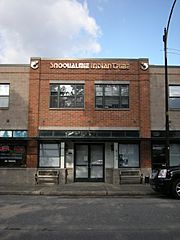Snoqualmie people facts for kids

|
|
| Total population | |
|---|---|
| 1,500 | |
| Regions with significant populations | |
| Languages | |
| English, Southern Puget Sound Salish language | |
| Religion | |
| Christianity, traditional tribal religion | |
| Related ethnic groups | |
| Duwamish, Puyallap, Nisqually, Sammamish, Suquamish, Skykomish, other Salish peoples |
The Snoqualmie people (Lushootseed: sdukʷalbixʷ) are a group of Coast Salish Native Americans. They traditionally lived along the Snoqualmie Valley in parts of King and Snohomish counties in Washington state.
Today, many Snoqualmie people are part of two official tribes recognized by the United States government: the Snoqualmie Indian Tribe and the Tulalip Tribes of Washington.
Contents
What's in a Name?
The Snoqualmie people are known by several names, like Snoqualmu or Snuqualmi. Their own name for themselves is sdukʷalbixʷ. This special word means "strong people of status." It shows how important and respected they were.
Speaking the Language
The Snoqualmie people speak a dialect of the Lushootseed language. This language is part of the larger Central Salish language family. Over time, more and more Snoqualmie people have started speaking English. However, efforts are being made to keep their traditional language alive.
A Look at History
Long ago, the Snoqualmie people lived in many villages. They had 58 large homes called longhouses. About 3,000 to 4,000 people lived in these villages. Their traditional lands were divided into four main areas. These areas are now near the cities of Monroe, Tolt, Fall City, and North Bend.
Important Leaders
A very important leader for the Snoqualmie people was Chief Patkanin. He was a strong and influential chief in the mid-1800s.
Treaties and Reservations
In 1855, the Snoqualmie people signed the Treaty of Point Elliott with the Washington Territory. After this, some Snoqualmie people moved to the Tulalip Reservation. However, many chose to stay on their ancestral lands. These lands were around the Snoqualmie Valley and Lake Sammamish. At that time, the Snoqualmie were one of the largest tribes in the Puget Sound area.
Changing Their Government
In 1916, the Snoqualmie people decided to change how their government worked. They wanted a system where the majority of people made decisions. They created four different councils to help lead the tribe:
- The General Council of the People
- The Council of Elders
- The Representative Tribal Council
- The Council of Chiefs
Jerry Kanim, who was Chief Patkanin's nephew, became the new chief after these changes. He remained chief for a very long time, even after his death in 1956. A new chief was not chosen until 1986.
A New Home and Casino
For many years, the Snoqualmie people tried to get a reservation on their traditional lands near the Tolt River. This river flows into the Snoqualmie River. Even though they tried many times, they were not able to get this land.
Instead, they bought land near Snoqualmie, Washington. On this land, they were granted a reservation. In 2008, the tribe opened the Snoqualmie Casino there. This casino helps support the tribe and its members.

